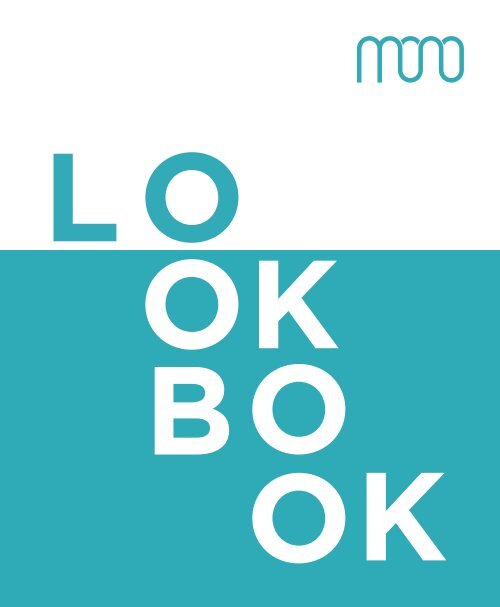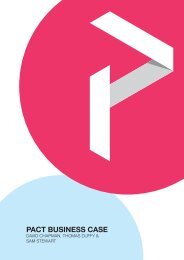Mono Magazine
Create successful ePaper yourself
Turn your PDF publications into a flip-book with our unique Google optimized e-Paper software.
<strong>Mono</strong><br />
<strong>Mono</strong> facilitates the creation of dynamic video content through<br />
the use of simple motion control. It is an integrated filmmaking<br />
accessory designed to improve the skills and capability of the user<br />
by providing panoramic motion control. The device is coupled with<br />
an intuitive smartphone or tablet application to provide complete<br />
control over the image-capture device and the shot.<br />
The compact device is fitted to the base of a camera or<br />
smartphone attachment through the utilisation of the<br />
standardised thread system evident in most camera accessories.<br />
Once positioned, <strong>Mono</strong> allows the camera to be panoramically<br />
controlled, rotating 360 degrees laterally. With this, the device<br />
can perform four functions; video recording, time lapse recording,<br />
panorama image capture and stitching and object tracking with<br />
the aid of a remote control accessory.<br />
Given the nature of camera motion manipulation, the device was<br />
designed to place the emphasis on the visual video outcomes<br />
and as a result, streamline the process and educate the user.<br />
Through this platform the user is encouraged to experiment with<br />
the functions and apply them to fit their needs. Furthermore, with<br />
the introduction of additional motion control products such as<br />
camera sliders, dollies, booms and ziplines, the capability of the<br />
<strong>Mono</strong> device can be enhanced exponentially. <strong>Mono</strong> encourages<br />
user engagement through the gestural input interactions which,<br />
in turn, helps in understanding the filmmaking processes and the<br />
development of new skills.<br />
1 2
Research<br />
The data collection and research revealed that the industry of<br />
filmmaking is highly individualised with each person developing<br />
their own style of filming and editing to achieve a desired result<br />
through videos. Interestingly, the two categories of both amateur<br />
and professional filmmakers who participated in the research,<br />
shared similar values regarding their camera equipment.<br />
The proposal contained a number of key sections that aimed to<br />
realise the potential scope of the project. The aim was to create<br />
a product system to assist amateur filmmakers in creating and<br />
sharing their stories through the use of minimal resources by<br />
enhancing the potential of a device already owned by the user.<br />
The goal was to enhance the user engagement in filmmaking as<br />
well as the capacity to achieve professional capabilities.<br />
Throughout the research phase, the participants were encouraged<br />
to define their values of filmmaking tools. This provided valuable,<br />
insightful information such as image quality, product quality,<br />
functionality, price point, reliability and convenience. Furthermore,<br />
it was resolved that the proposed design solution should<br />
enable filmmakers to enhance their professional capabilities by<br />
encouraging creativity through using the tools accessible to them.<br />
Ultimately, this would amplify the users ability to create and share<br />
stories and in the process, the filmmaker would become educated<br />
through active engagement in the filmmaking process, gain new<br />
knowledge and improve on existing skills.
Design<br />
Due to the contextually versatile nature of filmmaking, the product<br />
was required to be adaptive whilst maintaining functionality. The<br />
solution was designed to encourage creative discovery through<br />
the process of experimentation. The <strong>Mono</strong> device was designed<br />
to accommodate the universal connections evident in third-party<br />
cameras in the market. This relates to cameras and the pre-defined<br />
features and functions incorporated into those products. The<br />
different physical characteristics among varying cameras include<br />
the size, interface, overall weight and weight distribution has been<br />
considered. Furthermore, cameras are generally customizable<br />
resulting in the physical characteristics of each model of camera<br />
being difficult to accommodate. Much consideration was given<br />
to the accommodation of most common consumer cameras.<br />
This was evidenced by experimentation and refinement through<br />
the design process. The <strong>Mono</strong> device is suitable for cameras<br />
ranging from smart phones to medium sizes cameras (DSLR).<br />
The compact form factor that doesn’t compromise power was<br />
designed to address the issues raised throughout the data<br />
collection phase regarding transportation considerations. The<br />
size, weight and build quality have been factored into the design<br />
resulting in a robust product suitable for most contexts.<br />
The connectivity and integration of the <strong>Mono</strong> devices to other<br />
electronic devices, such as smartphones and cameras, aimed<br />
to be as seamless as possible, through using recognisable and<br />
stable technology, such as, bluetooth. The hardware and software<br />
limitations have been considered and factored into the final design<br />
solution.
housing pt. 1<br />
mounting plate<br />
gear-set 5:1 ratio<br />
bearing<br />
motor hardware<br />
stepper motor<br />
pcb<br />
li-po battery<br />
bearing support<br />
housing pt. 2<br />
hardware<br />
silicone foot
Engineering<br />
A challenge that arose was power consumption and<br />
considerations. The larger form factor of stepper motors provided<br />
them with high torque capability however, has a sub-sequential<br />
high power consumption. To successfully make the <strong>Mono</strong> device<br />
portable, a Lithium-Ion battery was to be integrated within<br />
the small form factor. In considering this, stepper motors were<br />
researched to find a model that had a low profile, high torque and<br />
low power consumption. A five volt stepper motor was found that<br />
used gears effectively to increase the torque whilst remaining<br />
compact and energy efficient. The discovery of this motor and its<br />
power requirements influenced the form factor of the <strong>Mono</strong> device<br />
as the housing had to accommodate this as well as a Lithium-Ion<br />
battery.<br />
To integrate the motor into the housing and effectively use it<br />
to its full potential, a gear ratio scheme was implemented. By<br />
introducing gears into the housing of the <strong>Mono</strong> device, the<br />
torque of the motor could be increased further whilst also<br />
reducing the power draw from the motor. For this to be effective,<br />
experimentation into gear-sets and configurations was undertaken<br />
to find the most suitable option. For this process, engineering<br />
gear generation tools were used to explore gear ratios and tooth<br />
interactions to maximise the efficiency of the system.<br />
Once developed, these were laser cut using acrylic and tested<br />
using a simple jig. A planetary gear-set was explored as the<br />
configuration to provide rotation translation effectively through<br />
the use of multiple gears and ratios. The challenge with using a<br />
planetary gear-set was the driving motor that must be positioned<br />
in the governing axis. In the formation of the <strong>Mono</strong> device, this<br />
was a problem due to the axis being occupied by the mounting<br />
threads and the camera mounting shaft. An alternative solution<br />
saw the employment of a simple 5:1 gear ratio which decentralised<br />
the motor to cater to <strong>Mono</strong>s axis considerations whilst retaining<br />
the advantages of a planetary gear-set.
Application<br />
The application interface enables the user to view the frame<br />
being displayed and manipulate this by swiping, zooming and<br />
controlling the functions. There are four functions: video; time<br />
lapse; panorama and tracking each with a slightly different set of<br />
definable controls.<br />
The video section allows for control over the motion: including<br />
the start and end position; the speed; the duration; the frame rate<br />
and the mode. The mode section includes programmable actions<br />
such as: repeating; returning; ease control and continuous panning<br />
(until stopped).<br />
The time lapse, much like the video function, allows for defined<br />
start and end positions. Furthermore, the recording times, the<br />
play times (output length) and the pauses between incremental<br />
movements, are specified.<br />
Panoramas require a more intensive set-up as the camera settings<br />
must be defined before programming the <strong>Mono</strong> device. Once the<br />
settings on the camera are defined, the focal length, aspect ratio,<br />
orientation, exposure time, photo count and overlap must be<br />
specified for the device and the camera to work harmoniously. The<br />
result is a long, high-quality image comprised of many individual<br />
images digitally stitched together.<br />
Lastly, the tracking is simple to initiate with a pairing button that<br />
starts and stops the connection between the phone and the <strong>Mono</strong><br />
device. The <strong>Mono</strong> application offers a live preview in both video<br />
and time lapse modes. This permits the user to preview and adjust<br />
the defined motion program.
Branding<br />
The first process in this stage was generating a brand name<br />
followed by the creation of a logo. A thorough search using online<br />
resources was conducted to explore existing brands on the market<br />
and to be conscious of existing brand names, logos and brand<br />
language. As well as this, a trademark search was carried out<br />
to ensure the brand name was not conflicting in the trademark<br />
class in which <strong>Mono</strong> is located. From this, a shortlist of names<br />
was generated based on a variety of factors including sounds,<br />
syllables, letters, formation, and potential contextual applications.<br />
The outcome of this process was a name, and a typeset that<br />
aligned with the brand language. Following this, vector modelling<br />
tools provided a great means of exploration and a logo was<br />
eventually created. The <strong>Mono</strong> logo was inspired by a font, however,<br />
was constructed using circles and rectangles (Figure X). Once this<br />
logo was established and refined, a condensed version of the logo<br />
was created to cater to different contexts and applications, for<br />
example, a smartphone application icon.<br />
Within the branding realm, user experience elements were<br />
considered to work toward a holistic, coherent brand. Packaging,<br />
advertising, smartphone application interfaces and on-product<br />
logo applications were also explored to ensure the overall brand<br />
identity was consistent.
Sketching<br />
In the early ideation stages of design development, concept<br />
sketching was used to enable, rapid idea generation and object<br />
visualisation. This phase was an exercise in divergent thinking<br />
which involved exploring various different design avenues within<br />
the greater scope of the project. Sketching, in this context,<br />
allowed for quick expression of ideas which resulted in concepts<br />
that revealed qualities and relations that was otherwise difficult<br />
to envisage. This process in the initial ideation stage makes up a<br />
small yet integral part as design refinement progresses quickly<br />
and with greater attention to detail such as aesthetics, material<br />
and part break-ups, manufacturability, and form generation. As<br />
well as concept sketching, system mapping tools were used to<br />
visualise how elements of the system would work holistically and<br />
harmoniously.<br />
A combination of analogue and digital sketching was utilised to<br />
thoroughly explore all elements of the design. Digital sketching<br />
enabled features and applications not necessarily possible through<br />
analogue means. Context composition, material experimentation<br />
and overlaying are some examples of how digital sketching was<br />
used to generate ideas. Furthermore, computer aided design<br />
(CAD) software was used to generate block forms to use as<br />
underlays in both analogue and digital sketching. This was<br />
effective as it assisted in visualising the presence of a form as well<br />
as providing a sense of scale.
David Chapman<br />
davidchapmandesigner.com






